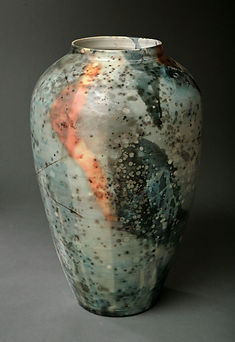
Wood
Fired
For thousands of years, ancient Asian ceramic artists and engineers have endeavored to design and build efficient wood-fired kilns which create distinctive surface designs uniquely identifiable with their kiln and the natural resources from their geographic region. The earliest wood-fired kilns were Tube Kilns or Anagama kilns. These tubular kilns evolved through the ages into Naborigama kilns (multi-chambered), wood-fired, hill climbing kilns.






At the Canton Clay Works, our unique Naborigama (designed by renown kiln designer Will Ruggles) has been fired over 300 times in the past 18 years, making it one of the more frequently fired wood kilns in the USA. For 48-50+ hours the kilns, numerous fireboxes are stoked with wood every 3-5 minutes. The pots in the first chamber are fired in a reduction atmosphere resulting in deep, rich color tone in the clay body, decorative slips, and glazes. The second chamber is considered a Soda Chamber, volatilized with 12 pounds of a salt and sodium mixture, resulting in an atmosphere saturated with vapor that bonds with the silica contained in the clay body, creating a one of a kind sodium silicate glaze.
Added to our kiln yard in 2018 our new Train Kiln (100+ cubic feet), a contemporary rendition of an ancient Anagama (tunnel or tube kiln). This new design was introduced to the U.S. by John Neely of Utah State University, after a trip to Japan. A unique feature of this design is the fire box, known as a burry box, with an unusual stepped grate system on the bottom of the burry box. This is an exceptionally efficient wood-fired kiln that fires faster, with great fuel efficiency resulting in similar results of an Anagama in far less time and energy.
Wood as fuel creates an atmosphere rich with volatilized metals and minerals such as potassium, calcium, and sodium. The vapor from these elements along with the airborne wood ash (fly ash), fuses to the clay body, decorative slips, and glazes, creating unique lyrical and timeless surfaces.
RAKU FIRED VESSELS
Traditional Raku firings emerged in the late 1400’s during the Ashikaga period in Japanese history.An indigenous process, it was adopted as the primary firing technique used to manufacture the original Buddhist Tea Ceremony vessels. Raku, a fast firing / fast cooling technique produced unusual one-of-a-kind vessels not previously seem in Japan.
The translation of Raku means, pleasure or ease

Contemporary ceramic artist have bastardized this ancient technique by adding unusual new steps to the firing procedure. After reaching approx 1800 degrees F, the individual wares are removed from the kiln and placed into a small pit lined with combustible materials such as straw, leaves, pine needles, and sawdust. The intense heat of the vessels ignites the combustible, producing a surge of flames that are then contained by covering with an inverted trash can or wash tub. This action chokes off the oxygen resulting, resulting in a reduction atmosphere. This post firing reduction creates unique, one-of-a-kind affects on the glazes and clay body in the wares.
Low-temperature Raku fired vessels are for decorative use only and should not be considered food safe.




SAGGAR FIRED VESSELS
Originally found in ancient China and Korea, saggars were containers used to protect wares from air born ash (fly ash) created during the firing of ancient wood and coal-fired kilns.

Today, many contemporary ceramic artists compact their saggars with organic materials (straw, sawdust, excelsior) that have been previously pickled in solutions of mineral salts. Using a combustion kiln, the vessels are fired for several hours in the temperature range of 1200-1500 degrees F. A myriad of colors can be achieved by firing both in reduction and oxidation. The mineral salts create a variety of beautiful soft pinks, blues, lite greens, burgundies, and peach tones with localized carbonized spots. The saturated combustibles in the sagger often volatilize into the porous ceramic wall in a recognizable organic pattern.
Before being fired, the wares are prepared with an ancient clay slip receipt from the Roman-Greco era known as Terra Sigillatta “earth seal”. Layers of very fine particle clay are painstakingly applied to the bone-dry clay vessel and then polished by hand, creating a glossy or satin colored finish.
Low-temperature Saggar fired vessels are for decorative use only and should not be considered food safe.





SAWDUST FIRED VESSELS
Throughout mans development and growing relationship with clay, patterns and subtle gradations of dark tones created by carbon has been a long existing common denominator in the firing and decoration of early ceramic wares. Before the development of kilns and the technology to fire at higher temperatures, cultural wares for food storage, food service and ritual wares were commonly fired in open pits using grasses, wood, and dung. These low-temperature firings often left beautiful carbonization patterns on the wares that were frequently decorated with colored slips.

Contemporary ceramic artists have adapted many of these ancient firing techniques to create a genre of “Smoke Fired Pottery”. Within this genre, I have pursued and developed for many years a technique called “Sawdust Fired Pottery”.
Before being fired, the wares are prepared with an ancient clay slip receipt from the Roman-Greco era known as Terra Sigillatta “earth seal” Layers of very fine particle clay are painstakingly applied to the bone-dry clay vessel and then polished by hand, creating a glossy or satin colored finish. Low-temperature sawdust fired vessels are for decorative use only and should not be considered food safe.
I use a variety of botanicals that I adhere to the exterior of the ceramic vessel, which I then submerge in a fire clay slurry, which acts as a resist. The wet wares are then placed into a rudimentary kiln filled with sawdust. The sawdust slowly smolders for a few days leaving wonderful carbonization patterns on the polished vessels.



